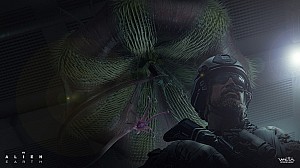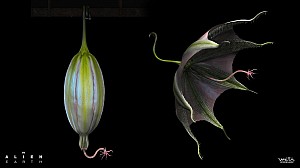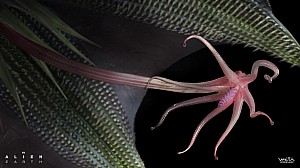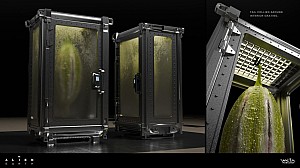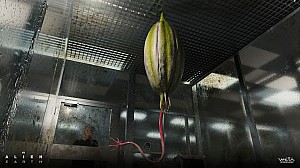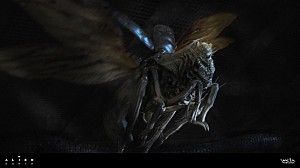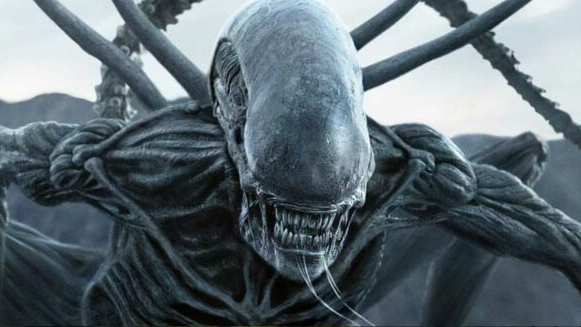Gary Bunn from the UK Aliens fan club interviewed Brian Johnson and Stuart Galloway for their fanzine magazine called facehugger Issue #2.
Brian Jonson and Stuart Galloway talk to Gary Bunn about their work on ALIEN and ALIENS.
The science fiction genre has always relied on the imagination and talent of the special effects technicians to translate ideas on paper, to picture on celluloid. Brian Johnson, one of the world's top special effects men, speaks about his work on our two favourite films.
Brian: I first started work on Alien in 1977, with a very talented team of thirty technicians working under me. As well as consulting the models, i was also there to supervise all of the optical effects.
Gary: Were you working from H.R. Giger's designs?
Brian: Well, Giger had designed the Alien itself, the alien vessel, but the rest had nothing to do with Giger. He actually came along to help us, but that was quite some time into the project. However, Giger did actually start on the designs at the very beginning of the production.
Gary: Do you still have any of the models from Alien?
Brian: I'm afraid not. Once we had finished filming, Twentieth Century Fox took all of the models and packed them off to America. They were put in some kind of exhibition. Sadly, they never stayed there for very long. Some pyromaniac decided to set light to them, and now they're lost for good. All that remains is a small piece of the Alien craft, which we sculptured out of plasticine.
Gary: Where were the models filmed?
Brian: All of the model effects were filmed at Bray Films Studios. The rest of the film, the live action, was shot on the big sound stage that they used to have at Shepperton.
Gary: How big was the model of the Nostromo?
Brian: well the Nostromo weighed well over a quarter of a tonne! In fact, it was so heavy, we had to mount it onto a steel beam. So I'm sure you can imagine, it was quite a large model. The Nostromo was one of those models which just kept evolving as we were working on it. Every now and again, a bit would be added here, a piece would be added there, so that's why it ended up being as big as it did.
Gary: What was it like working with Ridley Scott?
Brian: Fortunately, my time on Alien was very enjoyable, and having a director like Ridley Scott was great. He is just amazing and his work is superb.
Gary: Did you work on Aliens?
Brian: Yes i did. I was doing something very similar on Aliens. That was also a great experience for me, and it was a real pleasure to work with James Cameron. I was actually supposed to work on Alien 3, but honestly speaking, I'm quite pleased that i didn't now.
Gary: What have you been doing over the past few years?
Brian: Well, I've recently I've been working on the National Power ads, which were really good fun to do, and i think that they look equally as good as anything that the big American companies have done. When you consider the time that we spent on it, plus the tight budget, I'd say we did pretty good.
Gary: What sort of budget did you have for the Special Effects on Alien?
Brian: I think it was around £700,000, probably less, and by today's standards, that really is incredibly low.
Gary: I personally think that Alien is, and will remain, one of the science fiction classics. What did you think of the film?
Brian: I thought it was scary. Very scary indeed. Ridley Scott's direction was wonderful and the movie just looked brilliant. I'm not sure if Alien 3 will be as good as the original. I recently saw a trailer for the film, and it shows the creature in its entirety. I really think that's a big mistake. It left nothing to the imagination.. Part of the charm of the first movie is its tension and the uncertainty of what the Alien looks like. That way so much is left to the imagination of the audience. The audience hadn't a clue what the creature looked like, right until the very end of the film. But really, i suppose it's obvious that whatever the third film may look like, it's going to be a very big box office success.
Gary: So really, you prefer the first film, do you?
Brian: Yes. I think that Ridley had done a wonderful job with the film, despite him being a long way behind schedule - about six weeks, I think. Anyways, when time ran out on his shoot at Shepperton, he dismantled the sets, packed everything away in crates, and reconstructed everything at Bray, which is where us effects boys were working.
Gary: Did you have anything to do with the making of the Creatures?
Brian: No, but we did work closely with the makeup effects crew. The stuff that myself and my crew had done was really nothing to do with the construction of the actual Alien form.
Gary: On completion of Alien, what project was to be your next?
Brian: My next job was working on The Empire Strikes Back. But when i actually started work on that particular production, i was also still hard at work on Alien. Doing two films at once can be confusing and gets very, very hectic.
Gary: I gather that all of the effects shots that you do are all storyboarded first?
Brian: Yes, that's right. This is done so that we know exactly what each shot should look like. Plus, it is very helpful for continuity purposes. In fact, i still have some of the storyboards that we used for Alien, and a collection of Scott's rough sketches, which he made to show us what he wanted us to make. They were a very good guide for us.
One of the many technicians who had worked alongside Brian Johnson on Aliens was a talented Scotsman by the name of Stuart Galloway:
Stuart: Myself and Brian were in charge of all the opticals in Aliens, although we weren't actually credited for our work. If you were to watch the opening credits, you will notice that it says - "Certain Special Visual Effects created by the L.A Effects Group Inc." In actual fact, we had done more work on the film than they had.
Gary: So what was the reason for your not being credited for Aliens?
Stuart: From what I was told, there was some kind of contractual reason for them taking all the credit. The most frustrating thing was, they received an Oscar for our work. I think Brian deserved that more than anyone. After all, he won an Oscar for the first film, and winning the Oscar for the sequel would have been nice.
Gary: So which of the Special Effects scenes did you work on?
Stuart: I did the opticals for the Dropship, the Sulaco, etc. My favourite was the "Express elevator to hell". In other words, the Dropship sequence. The motion control on that particular scene was really good. So as the model of the ship moved, the camera moved along with it and followed it down towards the planet.
Gary: In Aliens - Special Edition, there are quite a few scenes that were not in the original cut of the film when it was first released in Great Britain. To your knowledge, are there any scenes still missing from the final print of Special Edition?
Stuart: No, not as far as know. I'm pretty sure that everything that we had done was left in the film. That includes all the space scenes, the filming of the models and the optical comparisons.
Gary: Are all shots of the spacecraft in flight classed as optical effects?
Stuart: About 99.9% of the time, yes. However, the very first scene of the film was actually shot 'in camera'. This means we never used the optical printer to combine the elements in the scene. In this case, the model of the shuttle and the deep space background.
Gary: Were you or any of your crew that you worked with, responsible for the construction of any of the Aliens models?
Stuart: No. Our job was purely opticals and shooting the models. I believe that they were constructed in America, and from what I'm told, they now reside at Pinewood Film Studios. I'm not sure exactly who owns them, though.
Gary: Was James Cameron a tough director to work with?
Stuart: Tough, but very talented. He kept on changing the opticals, right at the very last moment. But he really is a good director. He's a real perfectionist, and certainly, knows what he wants to see on film. Cameron is one of the few directors i have worked with that actually knows what he's talking about. I enjoyed working with him a great deal.
Gary: How long did you spend working on Aliens?
Stuart: I think that it was around four to five months for Aliens. And during that time we were working flat out. Unfortunately, Alien 3 was the one that eluded us. We were supposed to work on it, but in the end, the producers chose some other company. Another one for the Americans I'm afraid. Quite a pity really...

David Giler: Cinefantastique Interview
David Giler, who wrote scripts for MYRA BRECKINRIDGE, THE PARALLAX VIEW and FUN WITH DICK AND JANE, always seemed to get his office located down the h...

David Giler Alien 3 Starburst Special Interview October 1992
Alien 3 screenwriter David Giler guides us on the terrifying journey from script to screen. Why was there a third Alien movie? What were all the re-wr...

Did Alien 3 rip-off The Element of Crime?
In 1984, Danish filmmaker Lars von Trier (Melancholia, Dogville) began his directorial career with The Element of Crime, his first feature film. ...


